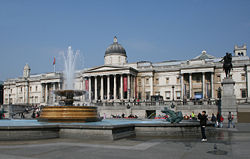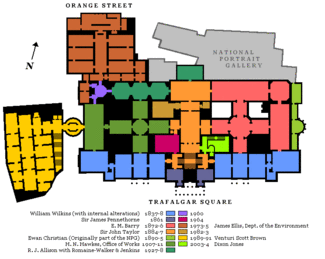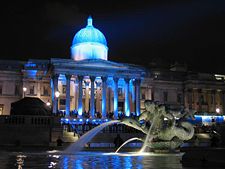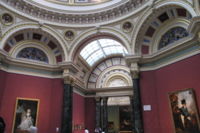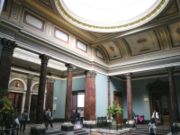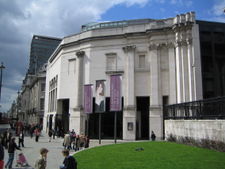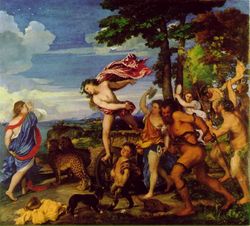National Gallery (London)
2008/9 Schools Wikipedia Selection. Related subjects: Architecture; Art
| The National Gallery | |
|---|---|
| Established | 1824 |
| Location | Trafalgar Square, London WC2, England, United Kingdom |
| Collection size | 2,300 paintings |
| Museum area | 46,396 m² |
| Visitor figures | 4,600,000 (2006) |
| Director | Martin Wyld (acting) |
| Nearest tube station(s) | Charing Cross, Embankment, Leicester Square |
| Website | www.nationalgallery.org.uk |
London's National Gallery, founded in 1824, houses a rich collection of over 2,300 paintings dating from the mid-13th century to 1900 in its home on Trafalgar Square. The collection belongs to the British public and entry to the main collection is free, although there are charges for entry to special exhibitions.
The National Gallery's beginnings were modest; unlike comparable galleries such as the Louvre in Paris or the Museo del Prado in Madrid, it was not formed by nationalising an existing royal or princely art collection. It came into being when the British government bought 36 paintings from the banker John Julius Angerstein in 1824. After that initial purchase the Gallery has been shaped mainly by its early directors, notably Sir Charles Lock Eastlake, and by private donations, which comprise two thirds of the collection. The resulting collection is small compared with the national galleries of continental Europe, but has a high concentration of important works across a broad art-historical scope, from the Early Renaissance to Post-impressionism, with relatively few weak areas.
The present building, on the northern side of Trafalgar Square, is the third to house the Gallery, and like its predecessors it has often been deemed inadequate. The façade by William Wilkins is the only part of his original building of 1832–8 that remains essentially unchanged, as the structure as a whole has been altered and expanded in a piecemeal manner throughout its history. Notable additions have been made by E. M. Barry and Robert Venturi. The National Gallery is currently without a director, but the art historian Nicholas Penny will assume the post in Spring 2008.
History
Foundation and early history
The unexpected repayment of a war debt by Austria finally moved the hitherto reluctant British government to establish a National Gallery, just as the art collection of John Julius Angerstein, a Russian émigré banker who had died the previous year, appeared on the market. On April 2, 1824, the House of Commons voted to purchase 38 of Angerstein's paintings, including works by Raphael and Hogarth's Marriage à-la-Mode series, for £57,000.
The National Gallery opened to the public on May 10, 1824, housed in Angerstein's former townhouse on No. 100 Pall Mall. Angerstein's paintings were joined in 1826 by those from the collection of Sir George Beaumont, which he had offered to give to the nation three years previously on the condition that a suitable building would be found to house them, and in 1828 by the Reverend William Holwell Carr's bequest of 34 paintings. Initially the Keeper of Paintings, William Seguier, bore the burden of managing the Gallery, but in July 1824 some of this responsibility fell to the newly-formed board of trustees.
The National Gallery at Pall Mall was frequently overcrowded and hot and its diminutive size in comparison with the Louvre in Paris was the cause of national embarrassment. Subsidence in No. 100 caused the Gallery to move briefly to No. 105 Pall Mall, which the novelist Anthony Trollope called a "dingy, dull, narrow house, ill-adapted for the exhibition of the treasures it held". In 1832 construction began on a new building by William Wilkins on the site of the King's Mews in Charing Cross, in an area that had been transformed over the 1820s into Trafalgar Square. The location was a significant one, described by the trustee Sir Robert Peel as being "in the very gangway of London" and thus equally accessible by people of all social classes. Later, in the 1850s, there were calls for a change of location, due in part to the pollution of central London and partly because of the failings of Wilkins's building, but it was felt that moving the National Gallery from Trafalgar Square would undermine public access.
Growth under Eastlake and his successors
15th- and 16th century Italian paintings were at the core of the National Gallery and for the first 30 years of its existence the Trustees' independent acquisitions were mainly limited to works by High Renaissance masters. Their conservative tastes resulted in several missed opportunities and the management of the Gallery later fell into complete disarray, with no acquisitions being made between 1847 and 1850. A critical House of Commons Report in 1851 called for the appointment of a director, whose authority would surpass that of the trustees. Many thought the position would go to the German art historian Gustav Friedrich Waagen, whom the Gallery had consulted on previous occasions about the lighting and display of the collections. However, the man preferred for the job by Queen Victoria, Prince Albert and the Prime Minister, Lord Russell, was the Keeper of Paintings at the Gallery, Sir Charles Lock Eastlake.
The new director's taste was for the Northern and Early Italian Renaissance masters or "primitives", who had been neglected by the Gallery's acquisitions policy but were slowly gaining recognition from connoisseurs. Eastlake made annual tours to the continent and to Italy in particular, seeking out appropriate paintings to buy for the Gallery. In all, he bought 148 pictures abroad and 46 in Britain, among the former such seminal works as Paolo Uccello's Battle of San Romano. Eastlake also amassed a private art collection during this period, consisting of paintings that he knew did not interest the trustees. His ultimate aim, however, was for them to enter the National Gallery; this was duly arranged upon his death by his friend and successor as director, William Boxall, and his widow Lady Eastlake.
The third director, Sir Frederick William Burton, laid the foundations of the collection of 18th century art and made several outstanding purchases from English private collections, including The Ambassadors by Hans Holbein the Younger. The last decisive influence in the shaping of the Gallery was the founding of the National Gallery of British Art, or the Tate Gallery as it was already being called, in 1897. The stipulation that paintings by British artists born after 1790 should be given to the Tate allowed the National Gallery to shed many of the superfluous works in its collection, while keeping those by Hogarth, Turner and Constable. As the building at the time was still comprised of only 15 rooms, this de-cluttering exercise proved to be a boon to the Gallery, allowing it to display its paintings by the British School with better focus than was previously possible.
The early twentieth century
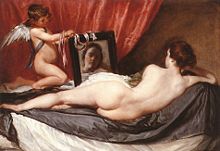
In 1906 Velázquez's Rokeby Venus, the first high-profile acquisition by the National Art Collections Fund, was the first of many artworks bought by the Fund for the National Gallery. In a rare example of the political protest for which Trafalgar Square is famous occurring in the National Gallery, the canvas was damaged on May 10, 1914 by Mary Richardson, a campaigner for women's suffrage, in protest against the arrest of Emmeline Pankhurst the previous day. Later that month another suffragette attacked five Bellinis, causing the Gallery to close until the start of the First World War, when the Women's Social and Political Union called for an end to violent acts drawing attention to their plight.
The bequest of 42 paintings given by the chemist Dr Ludwig Mond in 1909 was one of the largest ever received by the gallery and strengthened its holdings in the Italian old masters. During the 19th century the National Gallery contained no works by a contemporary artist, but this situation was belatedly amended by Sir Hugh Lane's bequest of Impressionist paintings in 1917. A fund for the purchase of modern paintings established by Samuel Courtauld in 1924 bought Seurat's Bathers at Asnières and other notable modern works for the nation; in 1934 these transferred to the National Gallery from the Tate.
Post-war developments
In the post-war years acquisitions have become increasingly difficult for the National Gallery as the prices for Old Masters – and even more so for the Impressionists and Post-impressionists – have risen beyond its means. Some of the Gallery's most remarkable purchases in this period would have been impossible without the major public appeals backing them, including The Virgin and Child with St. Anne and St. John the Baptist by Leonardo da Vinci (bought in 1962), Titian’s Death of Actaeon (1972) and Raphael’s Madonna of the Pinks (2004). Private individuals have continued to give their support, the most generous of whom was the late Sir Paul Getty, who in 1985 gave the Gallery £50 million towards acquisitions. Ironically, the institution that posed the biggest threat to the Gallery's acquisitions policy was (and remains) the extremely well-endowed J. Paul Getty Museum in California, established by Getty's estranged father. Also in 1985 Lord Sainsbury of Preston Candover and his brothers, the Hon. Simon Sainsbury and Sir Timothy Sainsbury, made a donation that enabled the construction of the Sainsbury Wing. However, the decline in government funding for the Gallery has been a cause of frustration for the outgoing director Charles Saumarez Smith and the institution is considered, as of 2007, to be facing its 'worst acquisition crisis in over a century'.
In 1996 it was decided that 1900 would be the cut-off date for paintings in the National Gallery and the following year more than 60 post-1900 paintings from the National Gallery collection were given to the Tate on a long-term loan, in return for works by Gauguin and others. The agreement was remarkable for marking an end to a century of cool relations between the two galleries. Future expansion of the National Gallery may see the return of twentieth-century paintings to its walls. Another gap in the collection was addressed by a bequest from Sir Denis Mahon in 1999, an art historian and collector of Italian Baroque paintings at a time when they were considered beyond the pale by most in the profession. This prejudice extended to the National Gallery trustees, who declined the offer to buy a Guercino from his collection for £200 in 1945 (in 2003 it was evaluated at £4m). Mahon left the National Gallery 26 of his paintings, including works by Guido Reni and Correggio, on the condition that it will never deaccession any of its paintings or charge for admission.
The building
William Wilkins's building
The first suggestion for a National Gallery on Trafalgar Square came from John Nash, who envisaged it on the site of the King's Mews, while a Parthenon-like building for the Royal Academy would occupy the centre of the square. A competition for the Mews site was eventually held in 1832, for which Nash submitted a design with C. R. Cockerell as his co-architect. Nash's popularity was waning by this time, however, and the commission was awarded to William Wilkins, who was involved in the selection of the site and submitted some drawings at the last moment. Wilkins had hoped to build a "Temple of the Arts, nurturing contemporary art through historical example", but the commission was blighted by parsimony and compromise, and the resulting building was deemed a failure on almost all counts.
The site only allowed for the building to be one room deep, as a workhouse and a barracks lay immediately behind. To exacerbate matters, there was a public right of way through the site to these buildings, which accounts for the access porticoes on the eastern and western sides of the façade. They incorporate columns from the demolished Carlton House (the reuse of which was yet another stipulation of the commission) and their relative shortness result in an elevation that was deemed excessively low, and a far cry from the commanding focal point that was desired for the northern end of the Square. Also recycled are the sculptures on the façade, originally intended for Nash's Marble Arch but abandoned due to his financial problems.
According to a famous 20th century critique, the fussy arrangement on the roofline, comprising a dome and two diminutive turrets, is "like the clock and vases on a mantelpiece, only less useful". Even the space given to the National Gallery inside the building was ungenerous as the eastern half was occupied by the Royal Academy until 1868, when it moved to its present home in Burlington House.
The building was the object of public ridicule before it had even been completed, as a version of the design had been leaked to the Literary Gazette in 1833. Two years before completion, its infamous "pepperpot" elevation appeared on the frontispiece of Contrasts (1836), an influential tract by the Gothicist A. W. N. Pugin, as an example of the degeneracy of the classical style. Even William IV thought the building a "nasty little pokey hole". Opinion on Wilkins's façade has, however, mellowed considerably since the 19th century. The extent of this acceptance can be seen in the remarks of another royal commentator, the current Prince of Wales, who referred to it in a well-known speech of 1984 as a "much-loved and elegant friend". (See below)
Alteration and expansion (Pennethorne, Barry and Taylor)
The first significant alteration made to the building was the single, long gallery added by Sir James Pennethorne in 1860-1. Ornately decorated in comparison with the rooms by Wilkins, it nonetheless worsened the cramped conditions inside the building as it was built over the original entrance hall. Unsurprisingly, several attempts were made either to completely remodel the National Gallery (as suggested by Sir Charles Barry in 1853), or to move it to more capacious premises in Kensington, where the air was also cleaner. In 1867 Barry’s son Edward Middleton Barry proposed to replace the Wilkins building with a massive classical building with four domes. The scheme was a failure and contemporary critics denounced the exterior as "a strong plagiarism upon St Paul's Cathedral".
With the demolition of the workhouse, however, Barry was able to build the Gallery's first sequence of grand architectural spaces, from 1872 to 1876. Built to a polychrome Neo-Renaissance design, the Barry Rooms were arranged on a Greek cross-plan around a huge central octagon. Though it compensated for the underwhelming architecture of the Wilkins building, Barry's new wing was disliked by Gallery staff, who considered its monumental aspect to be in conflict with its function as exhibition space. Also, the decorative programme of the rooms did not take their intended contents into account; the ceiling of the 15th- and 16th century Italian gallery, for instance, was inscribed with the names of British artists of the 19th century. But despite these failures, the Barry Rooms provided the Gallery with a strong axial groundplan. This was to be followed by all subsequent additions to the Gallery for a century, resulting in a building of clear symmetry.
Pennethorne's gallery was demolished for the next phase of building, a scheme by Sir John Taylor extending northwards of the main entrance. Its glass-domed entrance vestibule had painted ceiling decorations by the Crace family firm, who had also worked on the Barry Rooms. A fresco intended for the south wall was never realised, and that space is now taken up by Frederic, Lord Leighton’s painting of Cimabue's Celebrated Madonna carried in Procession through the Streets of Florence (1853–5), lent by the Royal Collection in the 1990s.
From 1928 to 1952 the landing floors of this vestibule were relaid with a new series of mosaics by Boris Anrep. Anrep was friendly with many members of the Bloomsbury Group, and shared their distaste for the attitudes and sentiments of the Victorian age. His mosaics at the National Gallery can be read as a satire on 19th-century conventions for the decoration of public buildings, typified by the elaborate sculptural programme of the Albert Memorial. Anrep subverted the pomposity and high moral tone of such works, offering his own set of Modern Virtues (including 'Humour' and 'Open Mind') in place of Christianity's seven virtues, and celebrating The Pleasures of Life (among them Christmas pudding) as well as its Labours. Discarding 'pantheons' of illustrious figures from the past, the mosaics put Anrep's own contemporaries on a pedestal: the central mosaic depicting The Awakening of the Muses includes portraits of Virginia Woolf and Greta Garbo, while Winston Churchill, Bertrand Russell and T. S. Eliot are among the allegorical figures in the Modern Virtues sequence.
Extensions to the West and North
Later additions to the west came more steadily but maintained the coherence of the building by mirroring Barry’s cross-axis plan to the east. The use of dark marble for doorcases and slate for skirting-boards was also continued, giving the extensions a degree of internal consistency with the older rooms. The classical style was still in use at the Gallery as late as 1929, when the Duveen gallery with its coffered, barrel-vaulted ceiling was built. The symmetry of the building was broken by the North Galleries, an unloved modernist extension which opened in 1975. "Ill proportioned [sic], poorly lit, and lack[ing] a positive architectural character" according to the 1997 National Gallery Report, these galleries were refitted in the 1990s in a style closely mimicking that of their 19th- and early 20th century neighbours. This was part of a larger programme of refurbishing the principal floor that had begun in 1985-6 with the restoration of the Barry Rooms.
The Sainsbury Wing and later additions
The most important addition to the building in recent years has been the Sainsbury Wing, designed by the leading postmodernist architects Robert Venturi and Denise Scott Brown to house the collection of Renaissance paintings and built in 1991. Building on the site had been delayed after Prince Charles infamously denounced a still evolving design for a modernist extension to the gallery by the architects Ahrends, Burton and Koralek as "a monstrous carbuncle on the face of a much-loved and elegant friend". The proposed extension then under consideration would have included a block of offices under the galleries. This proposal went as far as the display of a scale model at the Royal Academy in 1983. Only after the 1985 donation by John Sainsbury, Baron Sainsbury of Preston Candover and his brothers did a building exclusively for use by the National Gallery become financially feasible. Given the sensitivity of the site it is unsurprising that the Sainsbury Wing is subdued by Venturi's standards, superficially blending in with the Wilkins façade whilst offering a quirky comment on classical architectural idiom.
In contrast with the rich ornamentation of the rooms that either date from or emulate the 19th century, the galleries in the Sainsbury Wing are deliberately pared-down and intimate, to suit the smaller scale of many of the paintings. Sir John Soane's toplit galleries for the Dulwich Picture Gallery are the main inspiration for these rooms, and the white walls with grey pietra serena stone details (for door surrounds etc.) are a nod to the Florentine Renaissance architect Filippo Brunelleschi. The northernmost galleries align with Barry's central axis, so that there is a single continuous vista down the whole length of the Gallery. Looking towards the Sainsbury Wing from the main building, this prospect is given added drama by the use of false perspective as the paired columns flanking each opening gradually diminish in size until the visitor reaches the focal point of the vista (as of 2006), an altarpiece by Cima of The Incredulity of St Thomas. Venturi's postmodernist approach to architecture is in full evidence at the Sainsbury Wing, with its stylistic quotations from buildings as disparate as the clubhouses on Pall Mall, the Scala Regia in the Vatican, Victorian warehouses and Ancient Egyptian temples.
Following the pedestrianisation of Trafalgar Square, the Gallery is currently engaged in a masterplan to convert the vacated office space on the ground floor into public space. The plan will also fill in disused courtyards and make use of land acquired from the adjoining National Portrait Gallery in St Martin's Place, which it gave to the National Gallery in exchange for land for its 2000 extension. The first phase, the East Wing Project designed by Jeremy Dixon and Edward Jones, opened to the public in 2004. This provided a new ground level entrance from Trafalgar Square, named in honour of Sir Paul Getty. The main entrance was also refurbished, and reopened in September 2005. Possible future projects include a "West Wing Project" roughly symmetrical with the East Wing Project, which would provide a future ground level entrance, and the public opening of some small rooms at the far eastern end of the building acquired as part of the swap with the National Portrait Gallery. This might include a new public staircase in the bow on the eastern façade. No timetable has been announced for these additional projects.
Controversies
One of the most persistent criticisms of the National Gallery, alongside the perceived inadequacies of the building, has been of its policy regarding the conservation of paintings. The Gallery's detractors accuse it of having an over-zealous approach to restoration and of turning a deaf ear to criticism. The first cleaning operation at the National Gallery began in 1844 after Eastlake's appointment as Keeper, and was the subject of attacks in the press after the first three paintings to receive the treatment – a Rubens, a Cuyp and a Velázquez – were unveiled to the public in 1846. The Gallery's most virulent critic was J. Morris Moore, who wrote a series of letters to The Times under the pseudonym "Verax" savaging the institution's recent cleanings. While an 1853 Parliamentary Select Committee set up to investigate the matter cleared the Gallery of any wrongdoing, criticism of its methods has been erupting sporadically ever since from some in the art establishment.
The last major outcry against the use of radical conservation techniques at the National Gallery was in the immediate post-war years, following a restoration campaign by Chief Restorer Helmut Ruhemann while the paintings were in Manod Quarry. When the cleaned pictures were exhibited to the public in 1946 there followed a furore with parallels to that of a century earlier. The principal criticism was that the extensive removal of varnish, which was used in the 19th century to protect the surface of paintings but which darkened and discoloured them with time, may have resulted in the loss of "harmonising" glazes added to the paintings by the artists themselves. The opposition to Ruhemann's techniques was led by Ernst Gombrich, a professor at the Warburg Institute who in later correspondence with a restorer described being treated with "offensive superciliousness" by the National Gallery. A 1947 commission concluded that no damage had been done in the recent cleanings, but some in conservation circles remain unhappy that the Gallery's attitude towards restoration has changed little since Ruhemann's time.
The National Gallery has also come under fire for misattributing paintings. Kenneth Clark's decision in 1939 to relabel a group of paintings by anonymous artists of the Venetian school as works by Giorgione, (a crowd-pulling artist due to the rarity of his paintings), caused outrage and made him deeply unpopular with his own staff, who locked him out of the library. More recently, the attribution of a 17th century painting of Samson and Delilah (bought in 1980) to Rubens has been contested by a group of art historians, who believe that the National Gallery has not admitted the mistake to avoid embarrassing those who were involved in the purchase, many of whom still work for the Gallery.
Collection highlights
- English or French Medieval
- The Wilton Diptych
- Paolo Uccello
- The Battle of San Romano
- Piero della Francesca
- The Baptism of Christ
- Jan van Eyck
- The Arnolfini Portrait
- Sandro Botticelli
- Venus and Mars
- Leonardo da Vinci
- The Virgin of the Rocks, The Burlington House Cartoon
- Michelangelo
- The Entombment, The Manchester Madonna
- Raphael
- Portrait of Pope Julius II, The Madonna of the Pinks, The Mond Crucifixion
- Titian
- Bacchus and Ariadne, The Death of Actaeon
- Hans Holbein the Younger
- The Ambassadors
- Agnolo Bronzino
- Venus, Cupid, Folly and Time
- Michaelangelo Merisi da Caravaggio
- Boy Bitten by a Lizard, Supper at Emmaus, Salome with the Head of John the Baptist
- Peter Paul Rubens
- Le Chapeau de Paille, The Judgement of Paris (two versions), Landscape with Het Steen
- Nicolas Poussin
- A Bacchanalian Revel Before a Term, Landscape with a Man Killed by a Snake
- Diego Velázquez
- The Rokeby Venus
- Anthony van Dyck
- Equestrian Portrait of Charles I
- Rembrandt
- Belshazzar's Feast, two self-portraits
- Salvator Rosa
- Self-Portrait
- Johannes Vermeer
- Lady Standing at a Virginal, Lady Seated at a Virginal
- Canaletto
- A Regatta on the Grand Canal, The Stonemason's Yard
- William Hogarth
- Marriage à-la-Mode
- George Stubbs
- Whistlejacket
- Thomas Gainsborough
- Mr and Mrs Andrews
- Joseph Wright of Derby
- An Experiment on a Bird in the Air Pump
- J. M. W. Turner
- The Fighting Temeraire, Rain, Steam and Speed
- John Constable
- The Hay Wain
- Paul Cézanne
- Les Grandes Baigneuses
- Claude Monet
- The Water-Lily Pond, The Thames Below Westminster
- Pierre-Auguste Renoir
- The Umbrellas, Boating on the Seine
- Georges Seurat
- Bathers at Asnières
- Vincent van Gogh
- Sunflowers, Van Gogh's Chair, A Wheatfield, with Cypresses
